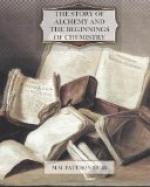ALCHEMY AS AN EXPERIMENTAL ART.
A modern writer, Mr A.E. Waite, in his Lives of the Alchemystical Philosophers, says: “The physical theory of transmutation is based on the composite character of the metals, on their generation in the bowels of the earth, and on the existence in nature of a pure and penetrating matter which applied to any substance exalts and perfects it after its own kind.” It must he admitted that the alchemists could cite many instances of transmutations which seemed to lead to the conclusion, that there is no difference of kind between the metals and other substances such as water, acids, oils, resins, and wood. We are able to-day to effect a vast number of transformations wherein one substance is exchanged for another, or made to take the place of another. We can give fairly satisfactory descriptions of these changes; and, by comparing them one with another, we are able to express their essential features in general terms which can be applied to each particular instance. The alchemists had no searching knowledge of what may be called the mechanism of such changes; they gave an explanation of them which we must call incorrect, in the present state of our knowledge. But, as Hoefer says in his Histoire de la Chimie, “to jeer at [the alchemical] theory is to commit at once an anachronism and an injustice.... Unless the world should finish to-morrow, no one can have the pretension to suppose that our contemporaries have said the last word of science, and nothing will remain for our descendants to discover, no errors for them to correct, no theories for them to set straight.”
[Illustration: FIG. VI. See p. 90.]
[Illustration: FIG. VII. See p. 90.]
[Illustration: FIG. VIII. See p. 91.]
What kind of experimental evidence could an alchemist furnish in support of his theory of transmutation? In answering this question, I cannot do better than give a condensed rendering of certain pages in Hoefer’s Histoire de la Chimie.
The reader is supposed to be present at experiments conducted in the laboratory of a Grand Master of the Sacred Art in the 5th or 6th century.
Experiment.—Ordinary water is boiled in an open vessel; the water is changed to a vapour which disappears, and a white powdery earth remains in the vessel.
Conclusion.—Water is changed into air and earth.
Did we not know that ordinary water holds certain substances in solution, and that boiling water acts on the vessel wherein it is boiled, we should have no objection to urge against this conclusion.
It only remained to transmute fire that the transmutation of the four elements might be completed.
Experiment.—A piece of red-hot iron is placed in a bell-jar, filled with water, held over a basin containing water; the volume of the water decreases, and the air in the bell-jar takes fire when a lighted taper is brought into it.




